Handgun retention is serious business for uniformed police officers who, as a matter of course, practice open carry. Special holsters with retention beyond a tight fit are mandated in most precincts, yet the list of police officers killed with their own guns sadly continues to grow. So what does this mean for civilians who openly carry their firearms? On January 1, 2016 the state of Texas will join the list of states no longer requiring concealed-handgun license holders to carry their weapons concealed. How many Texas CHL holders will immediately change their habits from stealth carry to out-in-the-open carry remains to be seen. Gun Tests doesn’t get into how people carry and use their legally owned firearms, but we recognize that some legal gun owners will want to open carry, which creates two issues the shooter has to deal with in advance. Mainly, the gun owner must maintain control of a carry firearm while still having fast access to it.
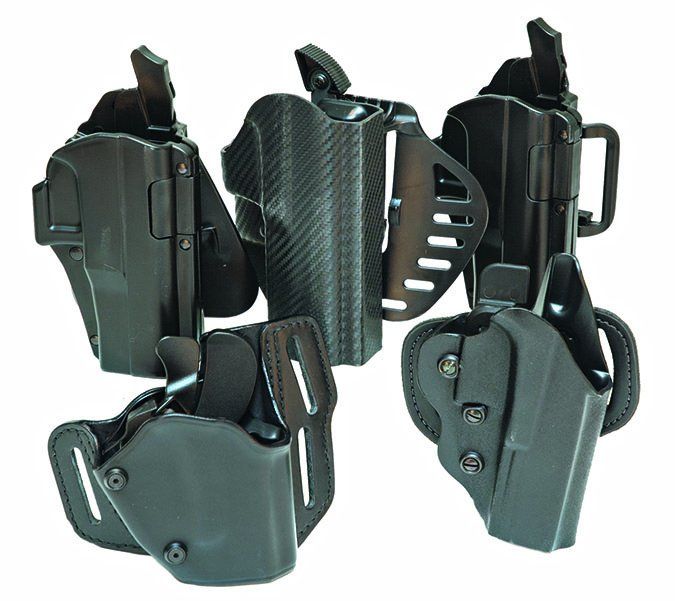
Joe Woolley, president of Firearms Operations and Responsible Training of Texas (FortTexas.us), thinks the new law might prompt licensees to carry larger firearms that are ordinarily more difficult to conceal. But more important, he said, “The security level of any open-carry holster I use will need to be higher than for the concealed firearm.” To see how manufacturers provide this extra security, we assembled a collection of 12 currently available holsters that supply more retention than most concealed models — that is, they require the manipulation of a locking device to draw the weapon. We’ll cover this dozen in two parts in back-to-back issues.
Our test holsters were Hogue Incorporated’s $50 ARS Stage One Carry, Galco’s M4X and M6X each priced at $45, Blackhawk’s $79 GripBreak, and the $32 Evader from Bianchi. In addition we tested three holsters from DeSantis, the $52 Facilitator, the $40 Quick Safe, and the $68 Prowler. We also tried a trio of holsters from Safariland, the $50 578 ProFit in Long and Standard sizes and Safariland’s $50 6378 ALS. Last, we also tried Blade Tech’s $124 WRS Level 3, which was much closer to being a police duty holster than what a civilian would typically wear. In this installment, we’ll tackle the Blackhawk GripBreak, DeSantis Facilitator, Galco M4X and M6X, and the Hogue ARS C.
Most people think a tight fit in a typical holster constitutes Level I retention and the addition of a thumb-break strap makes it a Level II holster. That’s not actually the case, any more than adding a mechanical locking device would change its rating to Level III. Retention ratings and their corresponding tests were originally developed by Bill Rogers, a former FBI agent and pioneer in modern police training. In purchasing the Rogers Holster Company in 1985, Safariland adopted his security rating system with tests intended to simulate a gun grab. Rogers’ Retention Level I test (trademarked) “is described as applying all the force to the grip or handle of the weapon by an individual while the weapon is totally secured in the holster and mounted on a suitable belt being worn by another individual. The direction of force is unlimited, but the duration of the force is limited to 5 seconds. At the end of the 5 seconds, the weapon must still be secure in the holster and the holster must still be attached to the operator.” By mounting each holster on a Blackhawk Instructor Gun Belt ($37 from OpticsPlanet.com) we made sure any failure would be traced back to the holster and not to the belt.
Our tests likely exceeded Bill Rogers’ protocol by wrestling to the ground for weapon control. We challenged retention using two types of grips, “educated” and “freestyle.” The educated grip describes how an instructor might handle the gun, with the trigger finger held straight alongside the frame with three fingers wrapped below the trigger guard, thumb hugging the opposite side of the pistol. The freestyle grip started with all four fingers beneath the trigger guard and thumb wrapped around the other side. We also tried grabbing the gun with the left hand from a right-hand-side-mounted holster. In the interest of security, we’re not going to tell you everything we learned about drawing from these high-retention holsters — just whether or not they might help protect you from a gun grab.
Blackhawk GripBreak 421903BK-R, $79
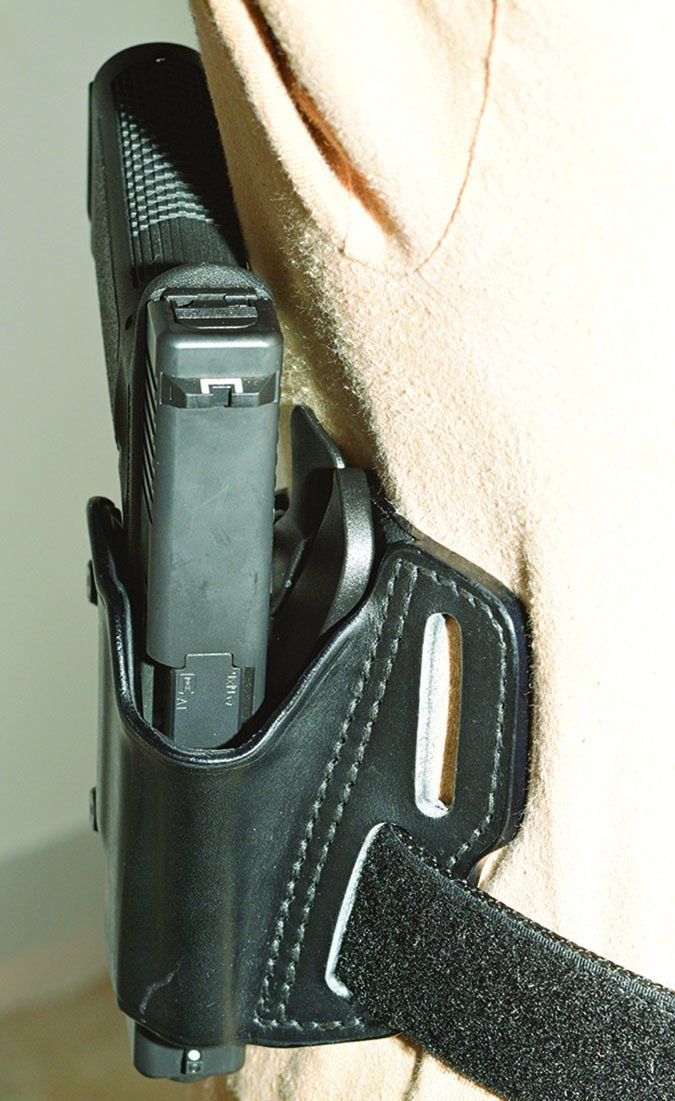
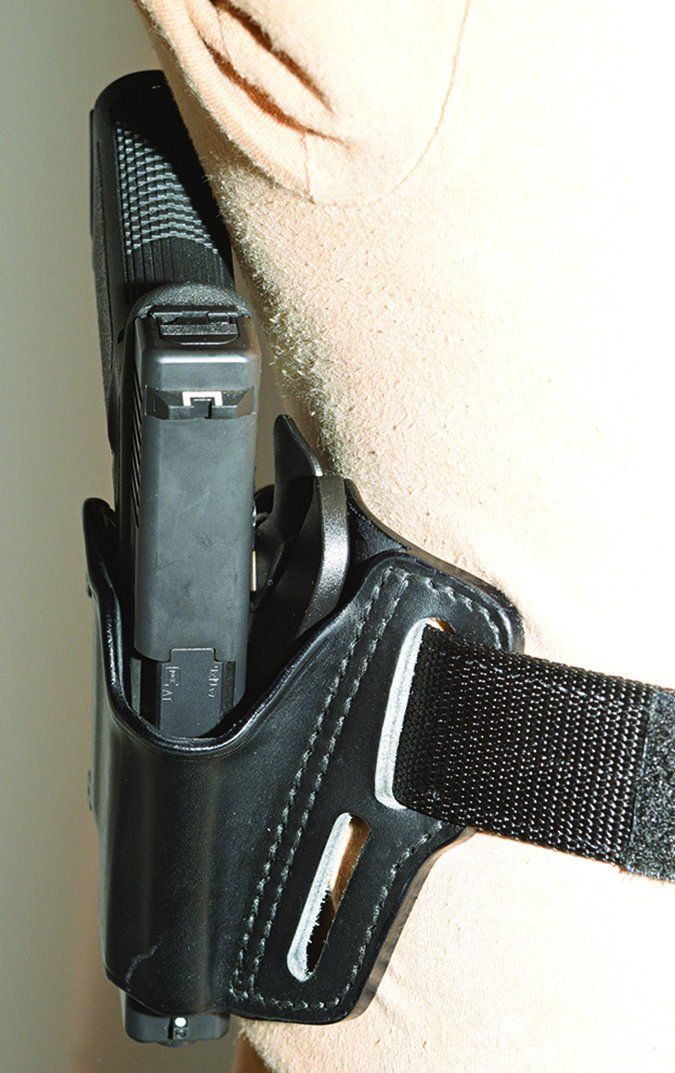
Our Blackhawk GripBreak holster featured an automatic locking system inside an inner shell covered by drum-dyed Italian leather. A less expensive GripBreak holster ($44) utilizes a 1000-denier Cordura nylon outer covering, but the leather model borders on the exquisite. Given most higher-retention holsters look robotic rather than classic, we think the GripBreak’s appearance may serve well to camouflage its true capabilities. To date, the GripBreak is produced to accommodate only the full-size Smith & Wesson M&P series and Glock pistols no larger than the GL17 or GL22. Once in place, our Glock 17 showed little play, and the gun could be drawn quickly. The GripBreak’s open muzzle allows it to be used with different-length barrels over the same frame. Versatility was enhanced with its three belt-slot design. The option of carrying the gun straight, upright beneath the arm, raised the gun nearly above the belt line for easier concealment and in some cases makes the gun easier to defend. Looping the belt through the upper loop cants the muzzle rearward (or butt forward if you prefer) and makes the gun more difficult to access from the rear. When not being used, the lower front loop provided extra support and comfort when carrying a heavier gun. Belt retention using either combination of loops was without failure.
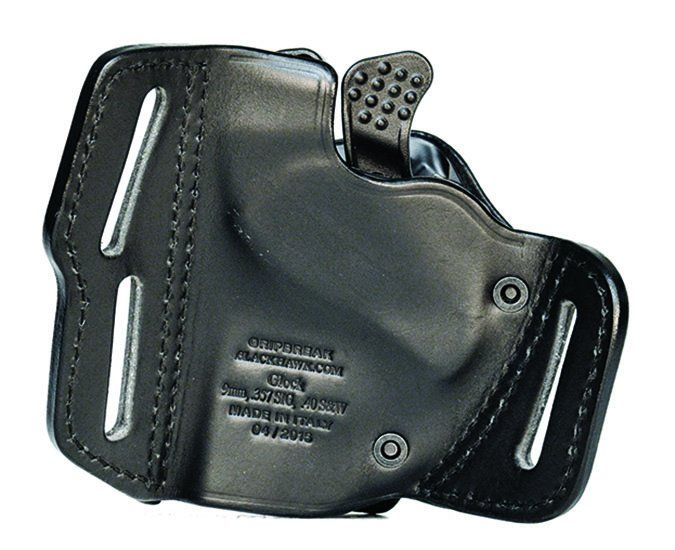
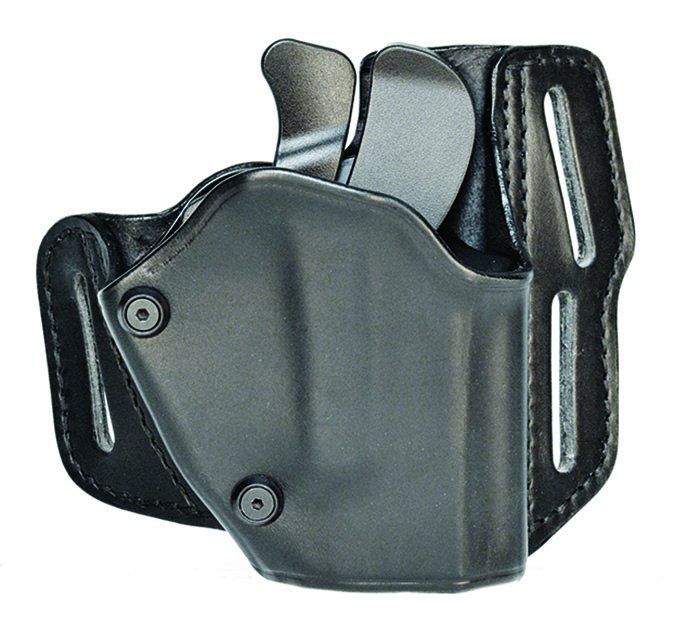
Our Team Said: What we liked best about the GripBreak was that it was most like the normal experience of wearing a holster when compared to other retention designs. The extra belt slot allowed the wearer to change the angle of the holster to where it was less accessible to anyone but the wearer, whether standing or seated in an automobile. We found this to be of the utmost importance since an educated grip produced an easy draw. Other grip attempts, however, had to get lucky to complete a release.
Gun Tests Grade: B+
DeSantis Facilitator 042KAB2Z0, $52
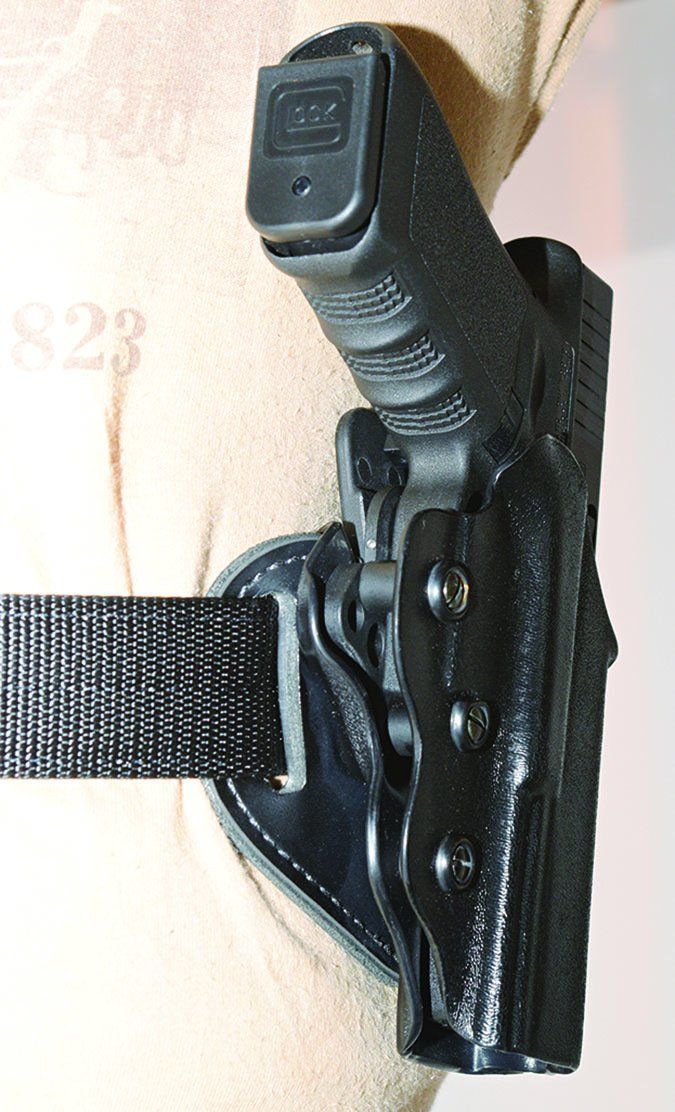
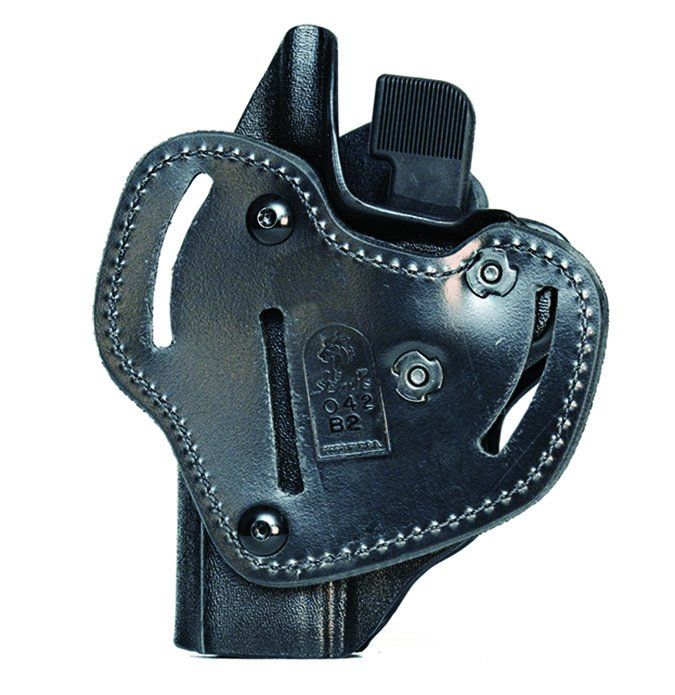
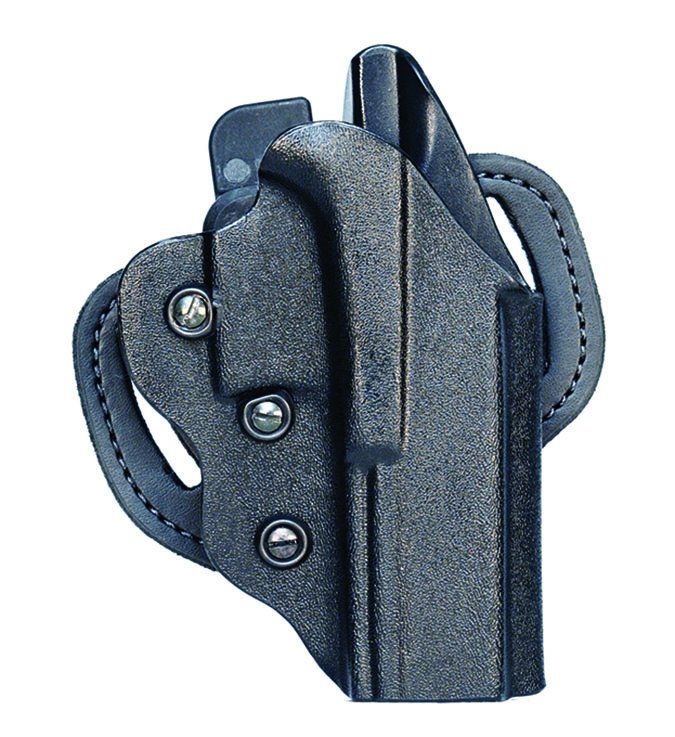
The Facilitator was connected to a leatherette backing, allowing it to bend with the shape of the body, but the holster body itself completely surrounded the pistol. Not intended for any mode other than on-the-belt carry, the Facilitator’s belt slots were 1.5 inches wide, but so shallow that only our thinner Instructor belt fit through them. The Facilitator was not adjustable for cant or height, but we thought the supplied angle was ideal. With the release lever buried between the left side of the pistol and the body, the slight muzzle-back cant made the lever invisible and operational by only the practiced grip of the wearer. The front of the holster was cut away to expose much of the slide, covering all but the forward portion of the ejection port. The Facilitator will fit full- and compact-sized Glock or Smith & Wesson M&P pistols.
Our Team Said: This was a comfortable holster to wear. Downside: The release was obvious, and any hand that gets between the body and the holster unit can easily release the weapon from this holster.
Gun Tests Grade: C
Galco M4X 224, $45
Galco M6X 224, $45
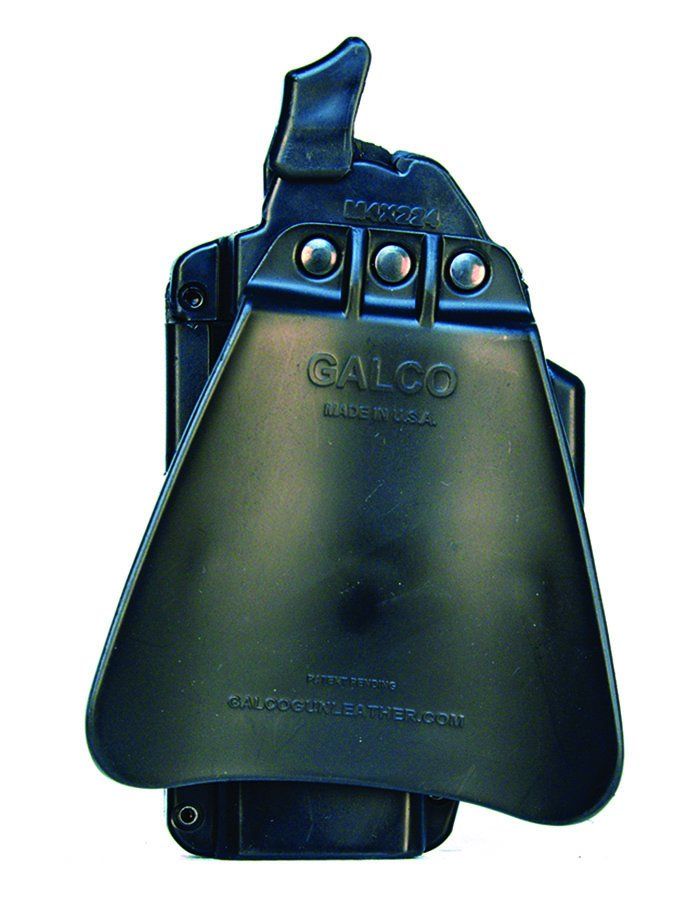
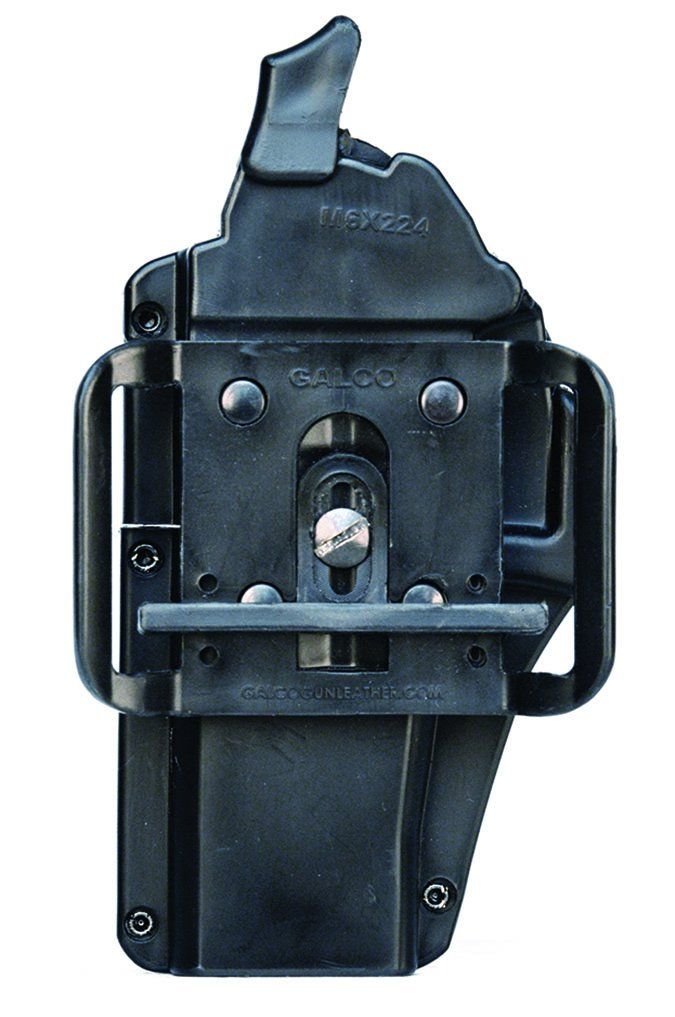
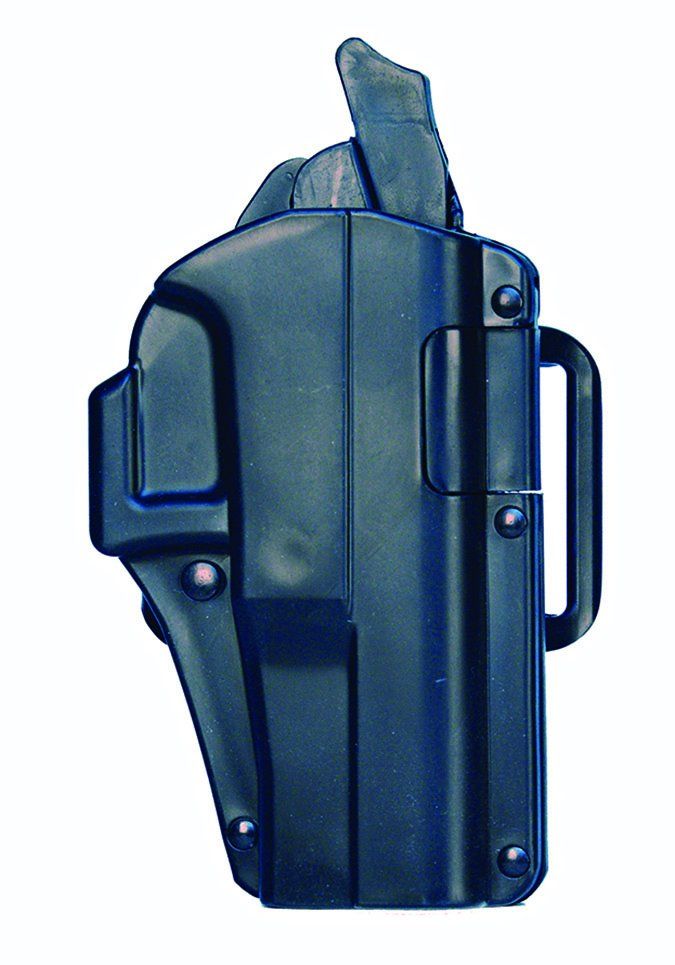
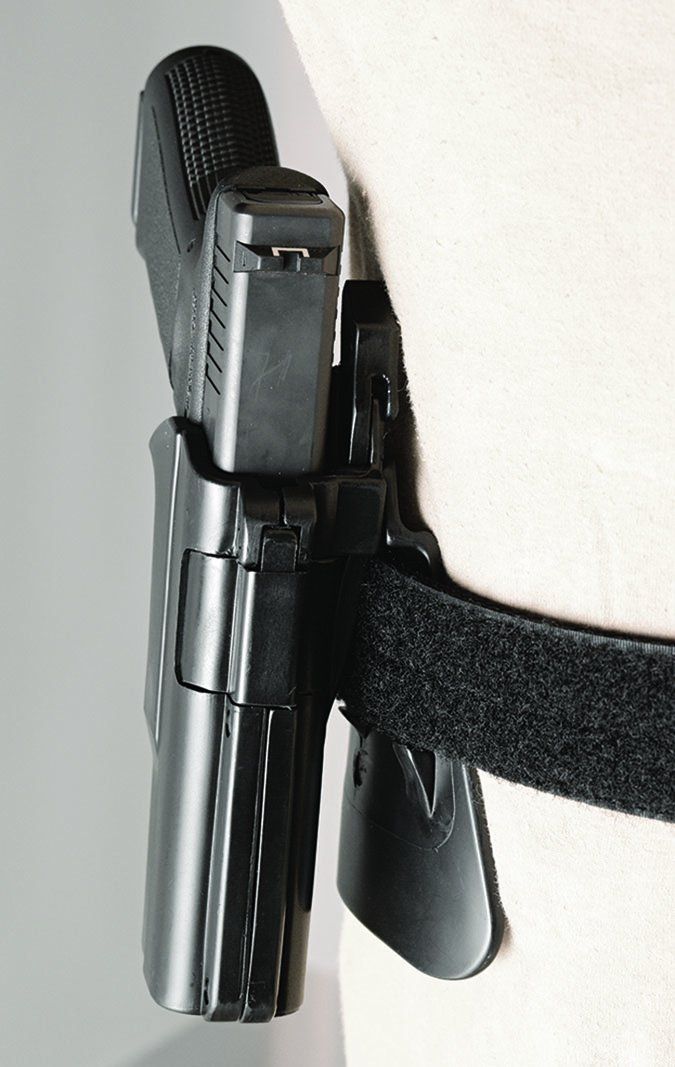
Both of the M4X and M6X holsters were formed via injection molded thermoplastic to fit the Glock 17 pistol. The only difference was the molding on the back of each holster. The M4X included a stanchion on which a paddle was riveted, and the M6X was fit with belt loops capable of threading belts up to 2 inches wide. A regulator was in place to reduce the width of the belt loops as necessary. The fit of our Glock 17 was tight inside both holsters, even if the M6X seemed to drag a little bit the first few times we drew. The thumb-release lever was well hidden from view. It was decidedly more easily operated by the person wearing the holster than from other angles. Our pair of Galcos achieved retention with pressure upon the edges of the ejection port rather than from inside the trigger guard. While not necessarily an advantage in itself, we did notice that if the gun were pulled with enough force before completely depressing the thumb release lever, the weapon would not release. That’s one plus, and here’s another. The owner can tell when the gun is properly locked into place by hearing the lock click and by seeing it settle into place. The thumb release was a simple (but heavily sprung) lever that lifted a form fit panel above the ejection port. With the lock fully engaged, we could see the panel seated flush with the holster body. More than making sure the weapon was secure, this introduced an alternate method of keeping the gun inside the holster in the event of a gun grab. In defense of a gun grab, the natural reaction is to either get to the grip first or push down on the trespasser’s hand to keep the gun inside the holster. With the Galco design, we found another way to keep the gun holstered. By gripping the holster body with the weak hand, pressing down on the panel that locks into the ejection port, the gun cannot be released. Whereas we found that the key to defending any thumb release lever holster is to limit access to the space between the body and the weapon/holster unit, for the Galcos, belt fit was critical. The M4X paddle holster seated tightly against the body, but in our tests the paddle slipped under the belt to incur a failure. The belt-looped M6X holster stayed properly connected to the belt, and by making sure the belt loops were sized properly, the unit remained firmly against the body.
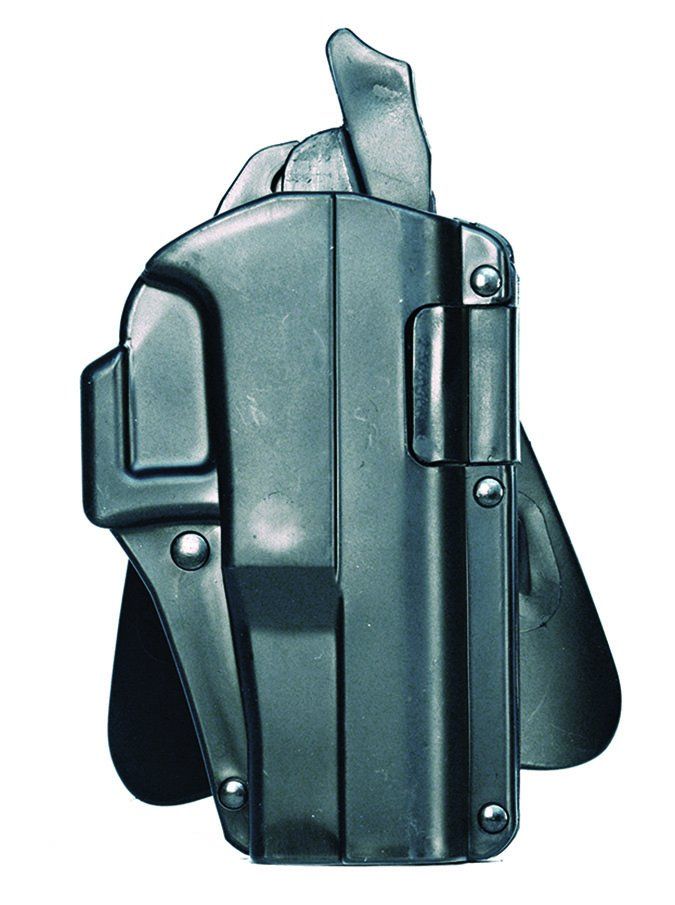
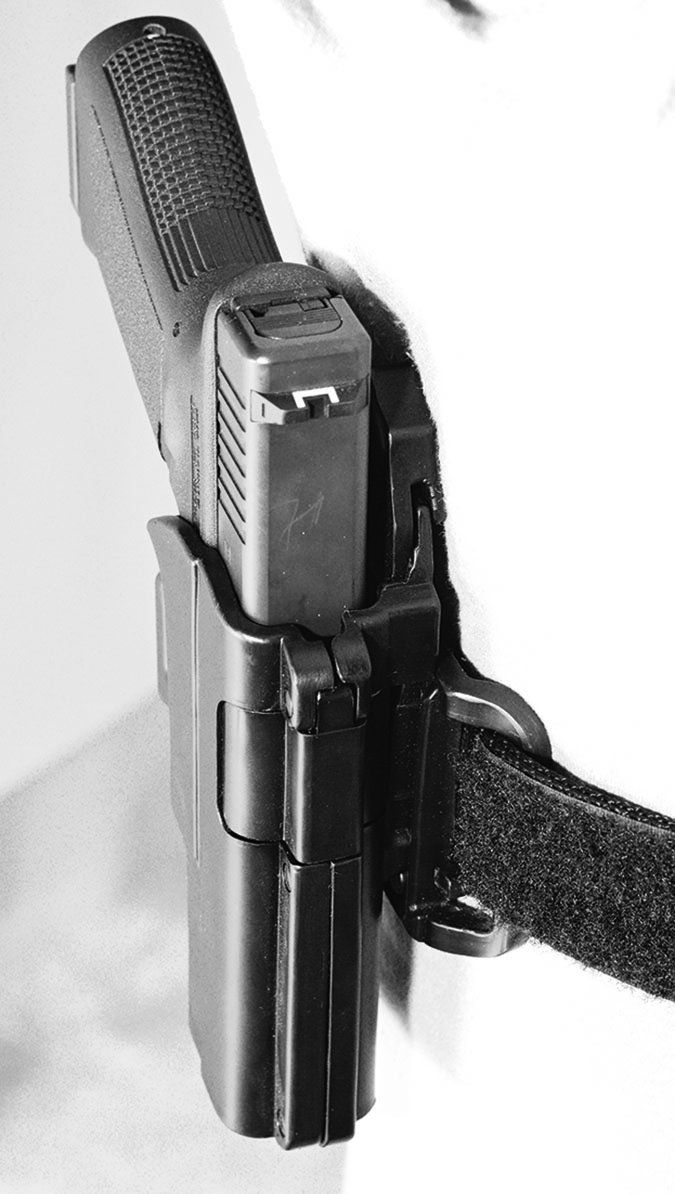
Our Team Said: The M4X and M6X holsters both offered a simple retention system that worked and offered the wearer a second chance for retention by manually holding the lock closed. In addition, activation of the thumb-release lever, whether on purpose or by coincidence, required a specific stroke to fully disengage. Bargain priced, the paddle on the M4X holster proved too weak for our tastes, but the belt-loop-fitted M6X is a very good pick.
Gun Tests Grade: A (M6X 224)
Gun Tests Grade: F (M4X 224)
Hogue Inc. ARS Stage One Carry CF 52872, $50
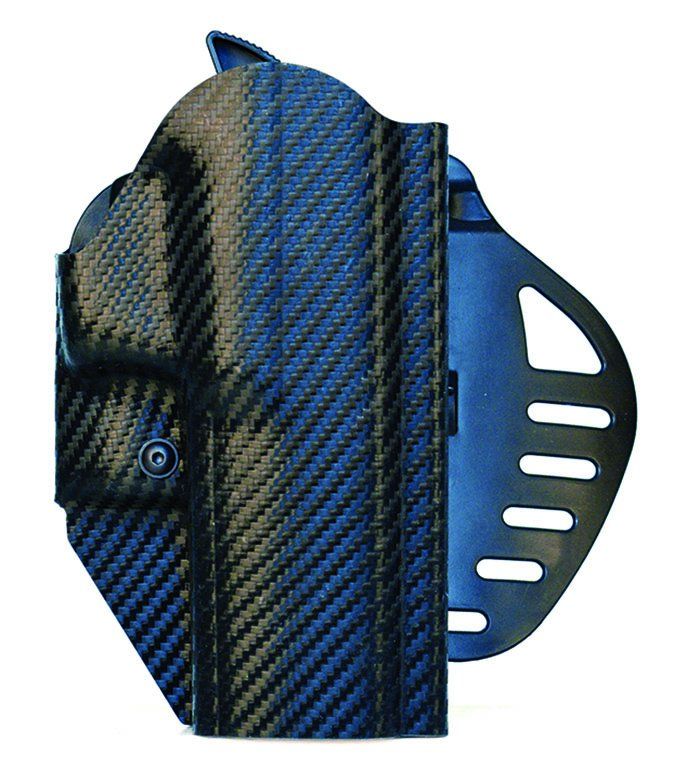
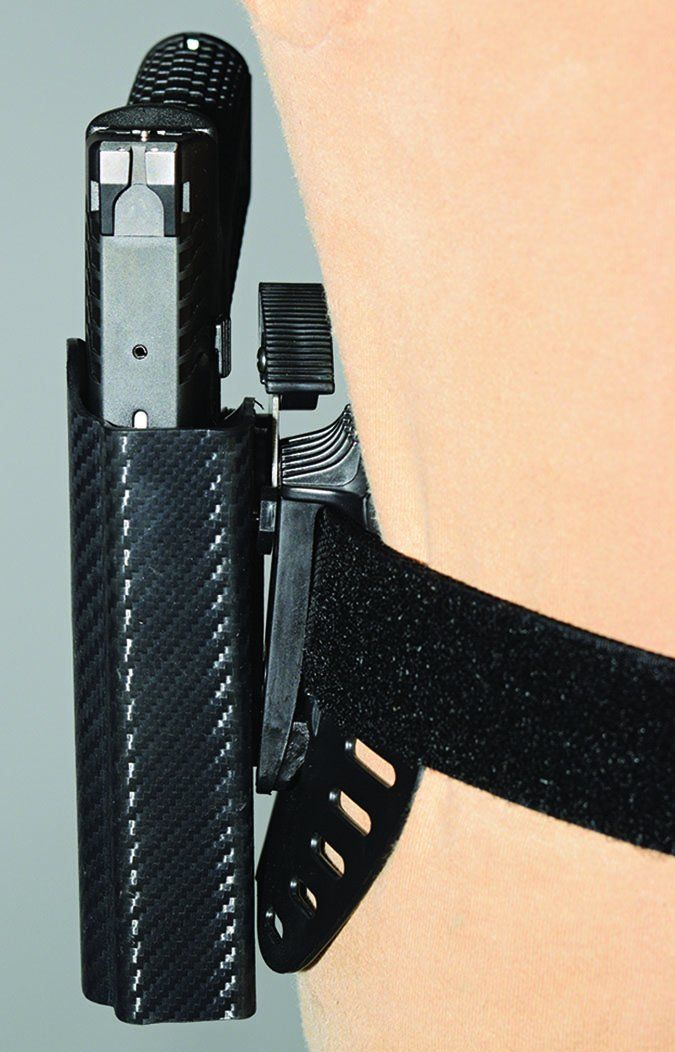
The CF signifies the optional carbon-fiber finish to this synthetic-construction thumb-release lever holster. Fit was very tight, with virtually no slop in the retention, yet the gun was not difficult to draw. Insertion was smooth, ending with a positive click. The ARS (automatic retention system) holster arrived with paddle in place, but the package included a belt-loop plate as well. The loops were extremely generous, measuring more than 2.1 inches top to bottom. Inserts to regulate ride height or reduce the belt slots to snug up against 1.5-, 1.25-, or 1.75-inch-wide belts were supplied. Both the paddle and the belt loop were adjustable for cant, and we found this to be a great advantage. Not only did this make cross draw possible, but adding muzzle-back cant to strong-side carry helped make this somewhat bulky holster easier to conceal. Canting the gun also made the release lever less accessible by tucking the unit closer to the body. The resulting grip angle also made it more difficult for an outsider to get hold of. The paddle failed to keep the unit attached to the wearer, flexing enough to allow it to be pulled from beneath the belt. The belt loops, however, proved secure and comfortable to wear in variety of angles.
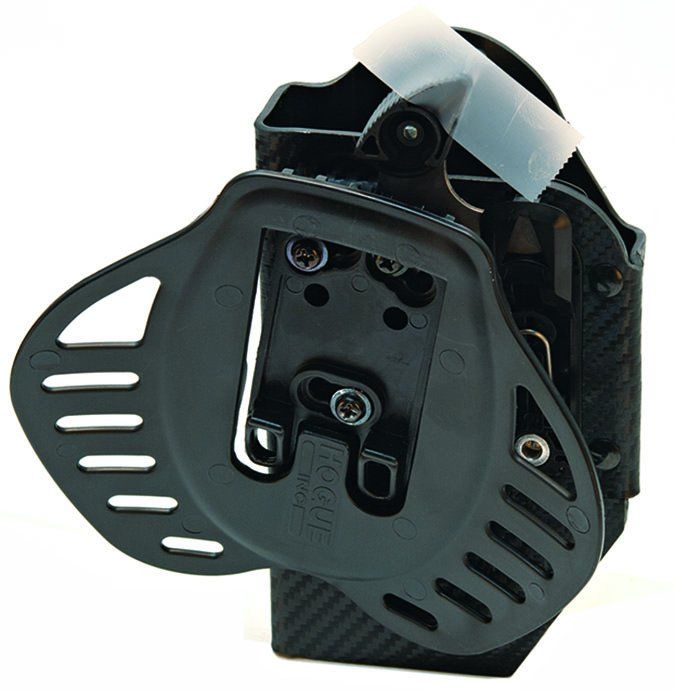
Our Team Said: The major weakness of this design is the size of the thumb-release-lever platform. In our view, it offered about twice the amount of surface area necessary for operation, leaving its rearmost section much too vulnerable to a grabber. The driveline strut lever was metal with a polymer platform lined for grip, all attached by a Phillips head screw. We think reducing the platform by about half would make this holster more secure from a gun grab and still leave plenty of surface area for the rightful user to activate the release.
Gun Tests Grade: B
Check in next month when we’ll test the Bianchi Evader, DeSantis Quick Safe and Prowler, Safariland’s 578 ProFit Long and Standard, Safariland’s 6378 ALS, and Blade Tech’s $124 WRS Level 3 holster.
Written and photographed by Roger Eckstine, using evaluations from Gun Tests team testers.





























kamagra livraison 24h [url=https://kamagraprix.com/#]kamagra 100mg prix[/url] Kamagra Commander maintenant
Cialis en ligne [url=https://tadalmed.com/#]Acheter Viagra Cialis sans ordonnance[/url] Cialis sans ordonnance 24h tadalmed.com
kamagra pas cher [url=https://kamagraprix.com/#]kamagra livraison 24h[/url] kamagra pas cher
Cialis en ligne [url=https://tadalmed.com/#]Tadalafil 20 mg prix en pharmacie[/url] Cialis sans ordonnance 24h tadalmed.com